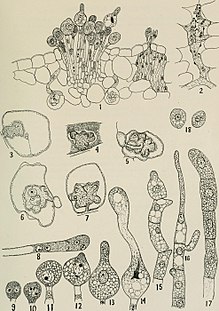
The Marasmiaceae are a family of fungi in the order Agaricales. Basidiocarps are most frequently agarics, but occasionally cyphelloid. According to a 2008 estimate, the family contained 54 genera and 1590 species, but molecular research, based on cladistic analysis of DNA sequences, has led to a more restricted family concept, so that the Marasmiaceae included just 13 genera, and some 1205 species. It was reduced further down in 2020, to 10 genera and about 700 species.

The Pucciniaceae are a family of rust fungi that cause plant diseases, mainly on cereals such as wheat. The family contains over 4900 species: many of them in the type genus Puccinia.
The Diademaceae are a family of fungi in the order Pleosporales. Taxa are widespread, especially in temperate regions, and are parasitic or saprobic in stem and leaves.
The Massariaceae are a family of fungi in the order Pleosporales. It contains 3 genera and 33 species. Taxa in the family have a cosmopolitan distribution, but are better known in more temperate zones. Although the family is poorly known, it has been suggested that they are saprobic in wood and bark, with a few species being weak pathogens.
The Pleomassariaceae are a family of fungi in the order Pleosporales. Taxa have a widespread distribution in both temperate and tropical regions, and are saprobic or necrotrophic on wood, bark, and other herbaceous material. The genus was circumscribed by mycologist Margaret Elizabeth Barr-Bigelow in 1979.
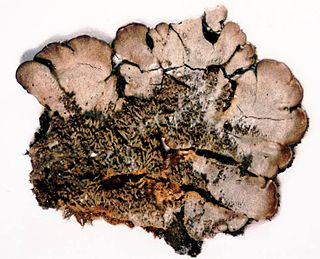
The Coccocarpiaceae are a family of lichen-forming in the order Peltigerales. There are three genera and about 60 species in the family. Species in this family have a widespread distribution, including boreal and austral regions.

The Psoraceae are a family of lichenized fungi in the order Lecanorales. The Austrian Botanist and Lichenologist Alexander Zahlbruckner first described the family in 1898. Species of this family have a widespread distribution.

The Sphaerophoraceae are a family of lichenized fungi in the order Lecanorales. Species of this family have a widespread distribution, especially in southern temperate regions. Sphaerophoraceae was circumscribed by mycologist Elias Magnus Fries in 1831.

The Coccotremataceae are a family of lichen-forming fungi in the order Pertusariales. Species in this widely distributed family grow on bark or rocks, especially in maritime regions.
Rhizomucor is a genus of fungi in the family Lichtheimiaceae. The widespread genus contains six species. Rhizomucor parasiticus, the species originally selected as the type, is now considered synonymous with Rhizomucor pusillus.

The Meliolaceae are a family of fungi in the order Meliolales. Mostly tropical in distribution, species in this family are biotrophic on the leaves and stems of plants. Despite this, most species do not cause extensive damage to the host plant, and are not generally considered to be of economic significance.
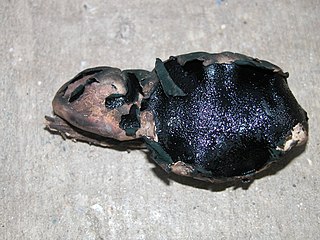
The Boliniaceae are a family of fungi in the Boliniales order. The family consisted of seven genera and 40 species in 2008. A new study found more genera and species in 2020.

The Brigantiaeaceae are a family of fungi in the order Teloschistales. Species in this family are lichenized with green algae, and are usually found growing on bark.
The Coccodiniaceae are a family of fungi in the order Chaetothyriales. The family was circumscribed in 1918 by Franz Xaver Rudolf von Höhnel as "Coccodiniaceen", the family was renamed by O.E. Eriksson in 1981. Species in the family have a widespread distribution and typically grow epiphytically or biotrophically on leaves and stems.
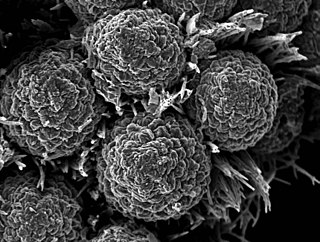
The Chaetosphaerellaceae are a family of fungi in the Ascomycota, class Sordariomycetes. The family was described in 2004. Species in the family have a widespread distribution, and are found in both temperate and tropical areas, where they grow saprobically on fallen wood.
The Ceratostomataceae are a family of fungi in the phylum Ascomycota, class Sordariomycetes, subclass Hypocreomycetidae and order Coronophorales.
The Niessliaceae are a family of fungi in the phylum Ascomycota, class Sordariomycetes. The family was updated in 2020.
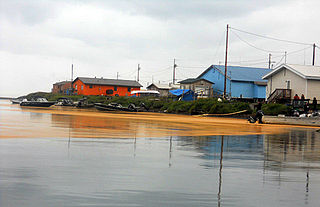
The Coleosporiaceae are a family of rust fungi in the order Pucciniales. The family contains 6 genera and 131 species. It was updated in 2020, to 7 genera and 173 species.

The Leptosphaeriaceae are a family of fungi in the order Pleosporales. The family was circumscribed by mycologist Margaret E. Barr in 1987. According to the Dictionary of the Fungi, the family contained 8 genera and 302 species. The family has a widespread distribution, but is especially prevalent in temperate regions. Species are either saprobic or grow as nectrotrophs on the stems or leaves of plants.
Achrotelium is a genus of rust fungi in family Zaghouaniaceae. The genus, previously placed in the Chaconiaceae, contains five species that are found in the USA, Philippines, India, and Zimbabwe.
